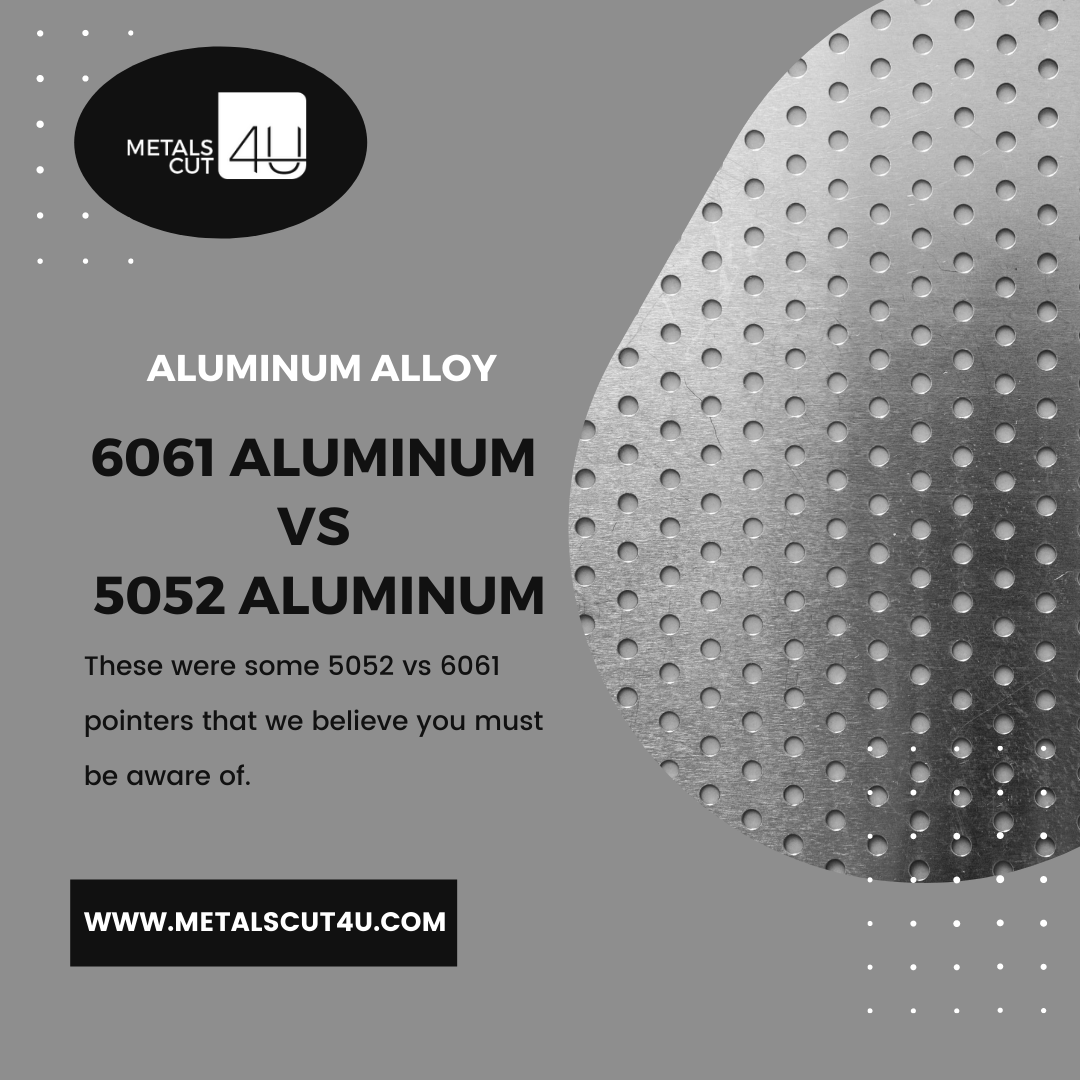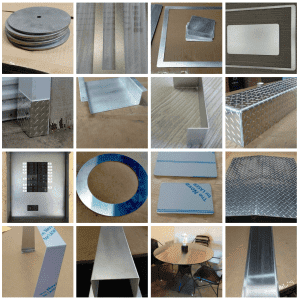Aluminum Alloy: Difference Between 5052 Aluminum vs 6061 Aluminum

An alloy is basically an improved engineering material that is made by imbuing a base metal with small amounts of different metals. As a matter of fact, aluminum is one of the most popular base metals out of all the metals in the market. Due to its high versatility, corrosion resistance properties, and high tensile strength, aluminum is often the first choice for most manufacturers. For industrial use, these aluminum alloys are categorized into different categories based on their elements and specifications as at times becomes difficult to identify the alloy that suits your needs the best. Each unique alloy has been provided with a four-digit name. The first digit generally designates the basic alloying elements of that group known as the series number.
The alloy from the series 5xxx and 6xxx are the alloys that contain magnesium and magnesium with silicon properties, respectively. The most commonly used alloys from these two series are 5052 aluminum alloy and 6061 aluminum alloy. In this article, we have covered some prominent and significant factors that will help you learn more about the properties of these two alloys and understand the differences between the two. So without wasting any time further, let us explore this article.
What is 6061 aluminum alloy?
6061 aluminum alloy is one of the most popular aluminum alloys in the market. This alloy can be found in almost every corner of the market in today’s world. 6061 aluminum alloy consists of good corrosion resistance properties, weldability, machinability, and moderate-to-high strength levels. Its chemical composition consists of 1.0% Mg, 0.28% Cu, ).6% Si, 0.2% Cr, and 97.9% AI. However, these numbers can slightly change or differ based on impurity levels and manufacturing methods. 6061 aluminum alloy was first developed in 1935. Although it has the same density as pure aluminum, it is also important to note that while welding 6061 aluminum alloy, the materials might lose some strength over time and can be strengthened using the heat-treatment process if needed. Earlier this alloy was suitable for stress-corrosion cracking, but the addition of a small amount of chromium has made this aluminum alloy highly resistant to corrosion.
6061 aluminum alloy is extensively used as a construction material by most manufacturers in the market. It is most commonly used in the manufacturing of automotive parts or components. This alloy is also well suited for the construction of yachts, motorcycles, scuba tanks, bicycle frames, fishing reels, camera lenses, electrical fittings, valves, and couplings. In addition, 6061 aluminum alloy can also be used in making aluminum cans, aluminum foil paper, and many more. 6061-T6 and 6061-T4 are the two most common tempers of 6061 aluminum.
What is 5052 aluminum alloy?
5052 aluminum alloy is known for having some of the best welding characteristics, great finishing qualities, excellent saltwater corrosion resistance properties. Due to its many benefits, 5052 aluminum alloy is often considered the first choice for most pressure vessels and containers manufacturers. This alloy is also known for being the strongest non-heat-treatable sheet and plate metal for common use or applications. However, it is also important to note that this alloy is not easily machined and can only be strengthened using the work-hardening process, 5052-H32 being the most common procedure of all. Its chemical composition consists of 0.25% Cr, 2.5% Mg, and 97.25 % AI.
Another best part about 5052 aluminum alloy is that it does not contain any copper properties and is not susceptible to salt-water corrosion as other aluminum alloys in the market. Therefore making it a perfect choice for marine or sea applications such as natural gas tankers and structures that are sensitive to failure. These types of aluminum alloys are also commonly used in architectural facades, home & office appliances such as cabinets, fan blades, home freezers, and many more, in the transportation industry, and others. It is also often used in electronic enclosures and medical equipment.
What is the difference between 6061 and 5052 aluminum alloy?
We hope by now you have a better understanding of both these amazing groups of aluminum alloys. Customers often tend to get confused between the two and fail to identify the difference for the same. However, both 6061 aluminum and 5052 aluminum serve different purposes. In order to help you with the same, we have mentioned the major differences (5052 vs 6061) between the two which you must consider.
-
6061 aluminum alloy is generally best suitable for machining purposes, whereas 5052 aluminum is primarily used for sheet metal and welding applications.
-
6061 aluminum is much harder compared to 5052 aluminum to permanently deform and at times also show formability issues.
-
Compared to 6061 aluminum, 5052 aluminum has a lower yield strength. However, 5052 aluminum can serve well as it generally takes less work to the plastic or the permanent region of deformation.
-
5052 aluminum has a higher modulus of elasticity compared to 6061 aluminum alloy and therefore it excels as a forming alloy.
-
A larger modulus of elasticity and lower yield strength allows 5052 aluminum to be shaped and worked without the risk of breakage or damage.
-
On the other hand, 6061 aluminum alloy has opposite characteristics which make it difficult for it to deform and is also more susceptible to brittle fracture.
-
6061 aluminum has a low fatigue strength compared to 5052 aluminum. This means it can withstand more cycles of deformation than 6061 aluminum making it an excellent forming alloy choice in the market.
-
In the case of thermal conductivity, 6061 aluminum alloy has a higher thermal conductivity level than 5052 aluminum alloy. This means 6061 aluminum alloy can be a suitable material for heat dissipation applications.
Below we have summarized the table (5052 vs 6061) that will help you understand or achieve a better viewpoint for both of these aluminum alloys.
|
Material properties |
6061 aluminum alloy |
5052 aluminum alloy |
||
|
Units |
Metric |
English |
Metric |
English |
|
Yield Strength |
276 MPa |
40000 psi |
193 MPa |
28000 psi |
|
Modulus of Elasticity |
68.9 GPA |
10000 psi |
70.3 GPA |
10200 ksi |
|
Fatigue Strength |
96.5 Mpa |
14000 psi |
117 Mpa |
17000 psi |
|
Thermal conductivity |
167 W/m-K |
1160 BTU-in/hr-ft2-degrees Fahrenheit |
138 W/m-K |
960 BTU-in/hr-ft2-degree Fahrenheit |
|
Machinability |
Good |
Poor |
||
CONFIGURE IN 4 EASY STEPS
Is aluminum 5052 stronger than 6061?
We hope the above 5052 aluminum vs 6061 aluminum information you now understand that in some cases 6061 aluminum is better than 5052 aluminum and in some cases 5051 is better than 6061. Which alloy to choose primarily depends on the needs and requirements of the application. 6061 aluminum might fail in forming alloy but it succeeds as a machining alloy. On the other hand, 5052 is more difficult to machine due to its elastic nature which causes excessive wear and tears on tooling.
Depending on their capabilities the usage of these alloys can be determined. Therefore to say or identify which alloy is stronger than one can be an extremely difficult task. 6061 aluminum alloy is considered a more preferable alloy for general use and 5052 aluminum is a more preferable material for welded sheet work and marine applications.
These were some 5052 vs 6061 pointers that we believe you must be aware of. You can visit our website or contact us today to get access to the finest quality and reliable metals in the market that can fit well for every purpose and need.
